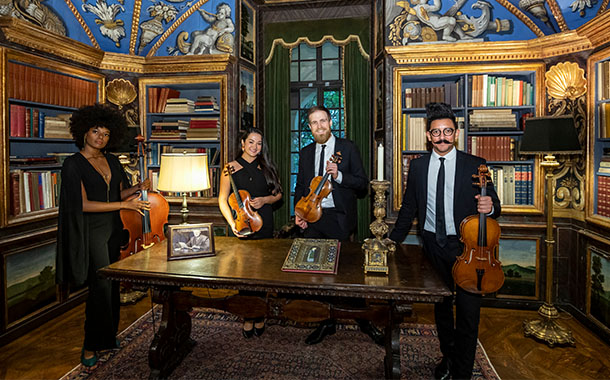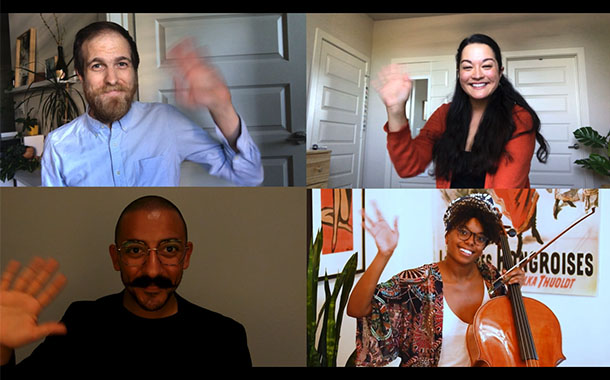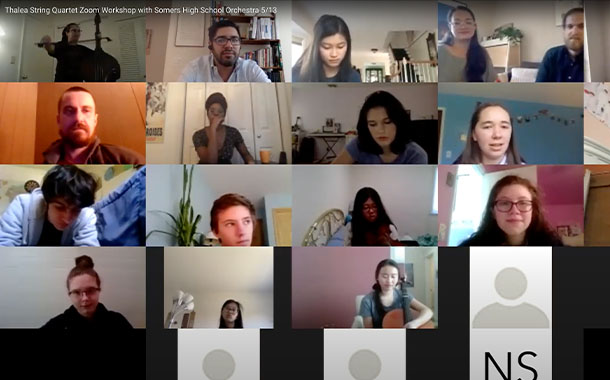The Thalea String Quartet Returns to Caramoor.
By Chris Witley, violinist of the Thalea String Quartet
By mid-March, with engagements postponed, flights cancelled, and forecasts for the future of live performance ranging from a bump in the road to something resembling a zombie apocalypse, the Thalea String Quartet faced the same uncertainty as every musician, ensemble, and arts organization in the world. When will we next see the inside of a concert hall? When will people feel safe enough to come to a live performance? How will we reach people with our art when we can’t even leave our own homes?
And yet, even as we asked ourselves these impossible questions, artists across the globe had almost instantly begun to address a desperate need for music. Artists set up live streams, online teaching, porch concerts, and music festivals in video games like Minecraft (don’t ask me how that works!). We suddenly had many new ways to enjoy music, which was helpful in counteracting the endless hours spent: disinfecting, hand-washing, and binge-watching Tiger King. Our Facebook feeds exploded with ingenious multi-track recordings—including new accompaniments from former Ernst Stiefel String Quartet-in-Residence—Verona Quartet, for our 20- second hand-washing routines. My favorite being the viola solo from Dvořák’s “American” Quartet.
One of the challenges for a young string quartet is finding an individual identity, a way to bring something new to the table.
With so many incredible string quartets in the world, how does one find their own unique voice?
In some ways, the rise of the “virtual concert hall” amplified this challenge. With so much fantastic online music-making, how was the Thalea String Quartet going to impact our audience and communities in a unique and meaningful way?

After our first visit to Caramoor in November 2019, we couldn’t wait to return to Katonah to continue our work with the area’s local young musicians. During our first residency as the Ernst Stiefel String Quartet-in-Residence, we taught, coached, and performed for over a thousand students. With the incredible support of the Caramoor team and the inspiring commitment of the local music teachers and administrators, we were able to develop educational programming that we will continue to implement for years to come.
In March, with our May visit approaching, and with schools in lockdown and air travel from our homes in Austin out of the question, the Caramoor team approached us in the hopes of providing some sort of musical activity for local schools in lieu of our in-person residency. After an inspiring Zoom meeting with Caramoor, we realized we had been provided with a golden opportunity. We had been given the tools, resources, and support to create a one-of-a-kind virtual residency that could reach students and community members in an impactful way, despite being separated by hundreds of miles.
For the Thalea String Quartet, an effective educational engagement experience typically includes a live performance, an interactive activity, and ideally some form of collaboration between teaching artist and student. Our goal was to approximate this as much as possible in a virtual setting. The live performance would be replaced with a series of pre-recorded videos, the interactive activity would be some form of Zoom meet-up, and the collaboration would involve student responses through social media or teacher-monitored online platforms like FlipGrid.
In brainstorming the “live performance” portion, and with the members of the quartet sheltering-in-place in different homes in Austin, we determined that any “live performance” from our quartet was out of the question for the time being. Instead, we opted for multi-track recording. Multi-track recording involves each member of the ensemble individually recording their own part, and then stitching the four videos together in post production. Pieces with abrupt changes in tempo or time signature are challenging to coordinate, as multi-tracking requires at least one member of the ensemble to use a click-track, or in-ear metronome. For us, that meant Bartók and late Beethoven were off the table for now. Prior to our discussions with Caramoor, we had been planning to dip our toes into multi-tracking with the theme and variations movement from Haydn’s “Emperor” Quartet. We also realized that this movement could serve as the foundation for our series of educational videos, and would allow us to clearly demonstrate the various roles of each member of the quartet. And what better place to start than Papa Haydn, the father of the string quartet?

We wrote and workshopped our video scripts with the help of violist John Largess of the Miró Quartet, one of our mentors at UT Austin and an Ernst Stiefel alumni. Each member filmed their individual scripts and Haydn parts, and after 30–40 hours of editing we had our final videos. Our goal was to approximate the spirit of our in-person educational performances: fun, approachable, and full of our individual and group personalities. The educational content needed to be clear, while staying engaging enough for students already exhausted by screen time.
Caramoor arranged for us to visit ten different school groups, including regional youth orchestras and a local conservatory. Each teacher we encountered was grappling with ever-changing curricular guidelines, student screen fatigue, and shifting educational goals, and had requested specific activities in the hopes that we could support their classroom work. These activities were a combination of masterclasses, Q&A sessions, and group discussions about practice and rehearsal techniques. Given our personal experiences with shoddy Wi-Fi connections and Zoom glitches, we weren’t sure how these in-class visits were going to work. But from the first day of our five-day virtual residency, these concerns were forgotten. We were consistently amazed by the resilience of the teachers and students. Teachers had mastered new technologies to ensure that their students were able to continue to learn and grow. Students, “rushing in” from online AP exams, or Zooming in from their homes in different corners of the world, performed for us with incredible artistry. We were equally impressed by the insightful comments and questions posed by students. Q&A portions, usually relegated to the final minutes of a session, now felt like the most valuable element of these in-class visits.
With positive feedback for both the video content and our in-class visits from teachers and students alike, we struggled to fully implement our collaborative activities. As with any experiment, there will be successes and areas for growth. Asking for response videos from students opened up a whole web of complexity around online privacy, educational expectations, and different school guidelines that have taken on increased importance now that school exists almost entirely online. While we see a lot of potential for online collaboration, and the creative potential of social media platforms like TikTok, we now recognize the unique challenges these activities pose.

Today, two weeks after our final “in-class visit,” the Thalea String Quartet is incredibly proud of our virtual residency with Caramoor. By the end of our five-day residency, we reached over 150 students. With the help of Caramoor, we developed a residency format that we are already repurposing for summer activities in the Austin area, and hoping to recreate at a large scale for cancelled summer programs across the province of Alberta. We were able to connect and impact a large community of students during an immensely challenging time, and have gained strengths within our ensemble that will help us face the uncertainty of our industry’s future. Thanks to Caramoor we have found a way not only to have an impact, but to contribute in a unique way to the new landscape of our changing field. This project allows us to be excited, instead of afraid, hopeful, rather than hopeless, and we can’t wait to see what the future holds.
We would like to express our gratitude to the Caramoor team and to every teacher, student, and parent who gave us the opportunity to try out this crazy experiment. We can’t thank you enough, and hope to see you all in person someday soon.
Leave a Reply